Internet addiction: prevalence, types, symptoms, effects, and treatment
Table of content
- What is internet addiction?
- How common is internet addiction disorder (IAD)?
- What are the 5 types of internet addiction?
- What are the symptoms and signs of internet addiction?
- What are the risk factors for internet addiction disorder (IAD)?
- What are the effects of internet addiction?
- What are the treatment options for internet addiction?
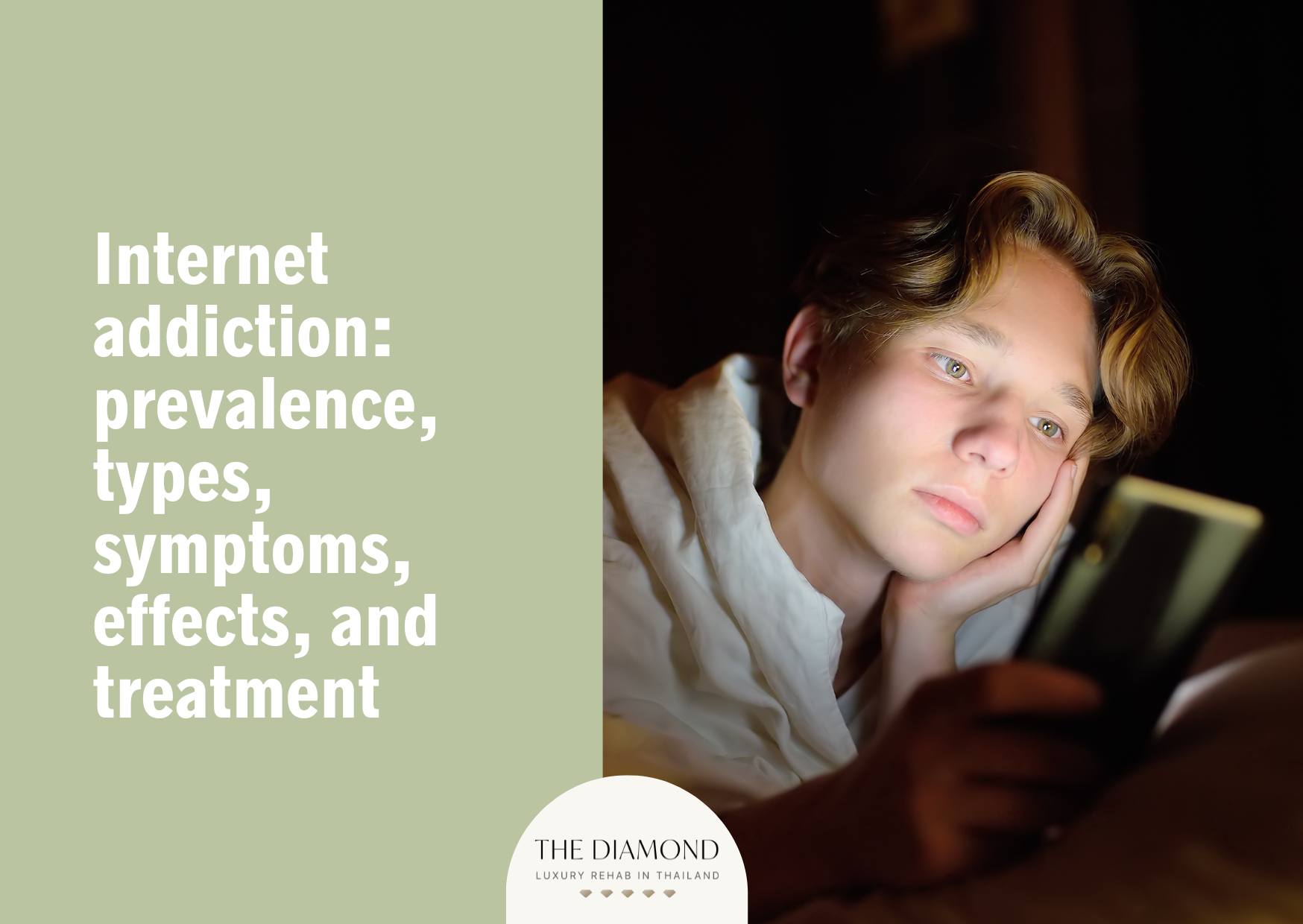
Internet addiction is defined as an overwhelming need to use the internet to the detriment of one’s health and daily functioning. Poor self-control over internet use results in damage to personal well-being, relationships, and professional responsibilities.
The prevalence of internet addiction worldwide is 14.22%, and men are more prone than women to become addicted.
The 5 types of internet addiction are cybersex addiction, cyber (online) relationship addiction, net compulsions, compulsive information seeking and internet gaming disorder (gaming addiction).
The symptoms and signs of internet addiction include sleep problems, muscle aches and pains resulting from inactivity, euphoria when online, unintended weight loss or weight gain, withdrawal symptoms, preoccupation with the internet, excessive time online, problems at work or school, withdrawal from face-to-face social interactions and lying about internet use.
The effects of internet addiction include health risks, sleep disorders, poor academic performance, impaired relationships, social isolation, and mental health struggles.
Treatment options for internet addiction are psychotherapy, family therapy, group therapy, medication, and lifestyle adjustments.
What is internet addiction?
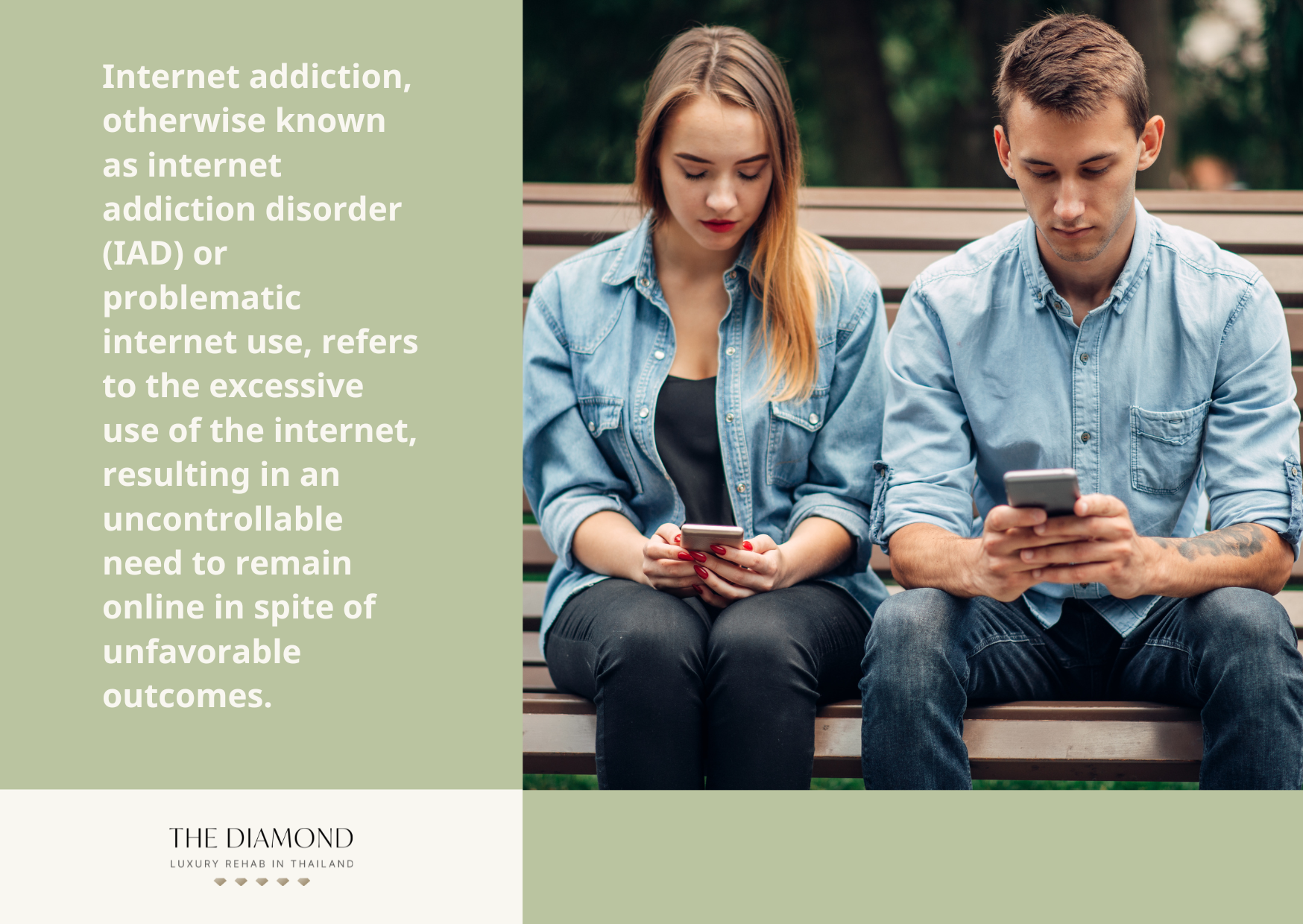
Internet addiction, otherwise known as internet addiction disorder (IAD) or problematic internet use, refers to the excessive use of the internet, resulting in an uncontrollable need to remain online in spite of unfavorable outcomes.
Individuals struggling with the condition experience difficulty limiting screen time, frequently losing track of hours spent online. The compulsive use of digital devices eventually turns into an unhealthy behavior, leading to an increase in stress and the replacement of real-world interactions.
Why is internet addictive?
The internet is addictive due to its ability to trigger dopamine release in the brain, reinforcing repetitive behaviors. Instant notifications, likes, and messages—among other rapid rewards—help create a loop of gratification, keeping people engrossed for extended periods of time.
With technology becoming more advanced and widely accessible, even kids are exposed to highly stimulating internet content. Platforms are designed to keep users engaged, using algorithms to personalize feeds and recommend content based on past behavior. Excessive screen time is further encouraged by social approval, engaging activities, and endless content.
How common is internet addiction disorder (IAD)?
The estimated global prevalence of internet addiction is 14.22%, according to a 2022 paper by Meng et al., titled “Global prevalence of digital addiction in general population: A systematic review and meta-analysis.”
The report further revealed men are more likely than women to become addicted to the internet (19.6% vs. 16.3%). Addiction to digital media, especially smartphones and the internet, is more common in low- and middle-income nations due to inadequate regulation and widespread use of digital technologies.
Internet addiction tends to affect younger age groups, especially adolescents and young adults. Numerous studies focus on younger people because they rely heavily on the internet for school, social interaction, and leisure.
In Asia, reported rates vary widely, from 6.3% to 37.9%. In the United States, the numbers stay lower, between 0.3% and 8.2%, though the problem remains relevant, according to a 2020 paper by Duong et al., titled “How has Internet Addiction been Tracked Over the Last Decade? A Literature Review and 3C Paradigm for Future Research.”
What are the 5 types of internet addiction?
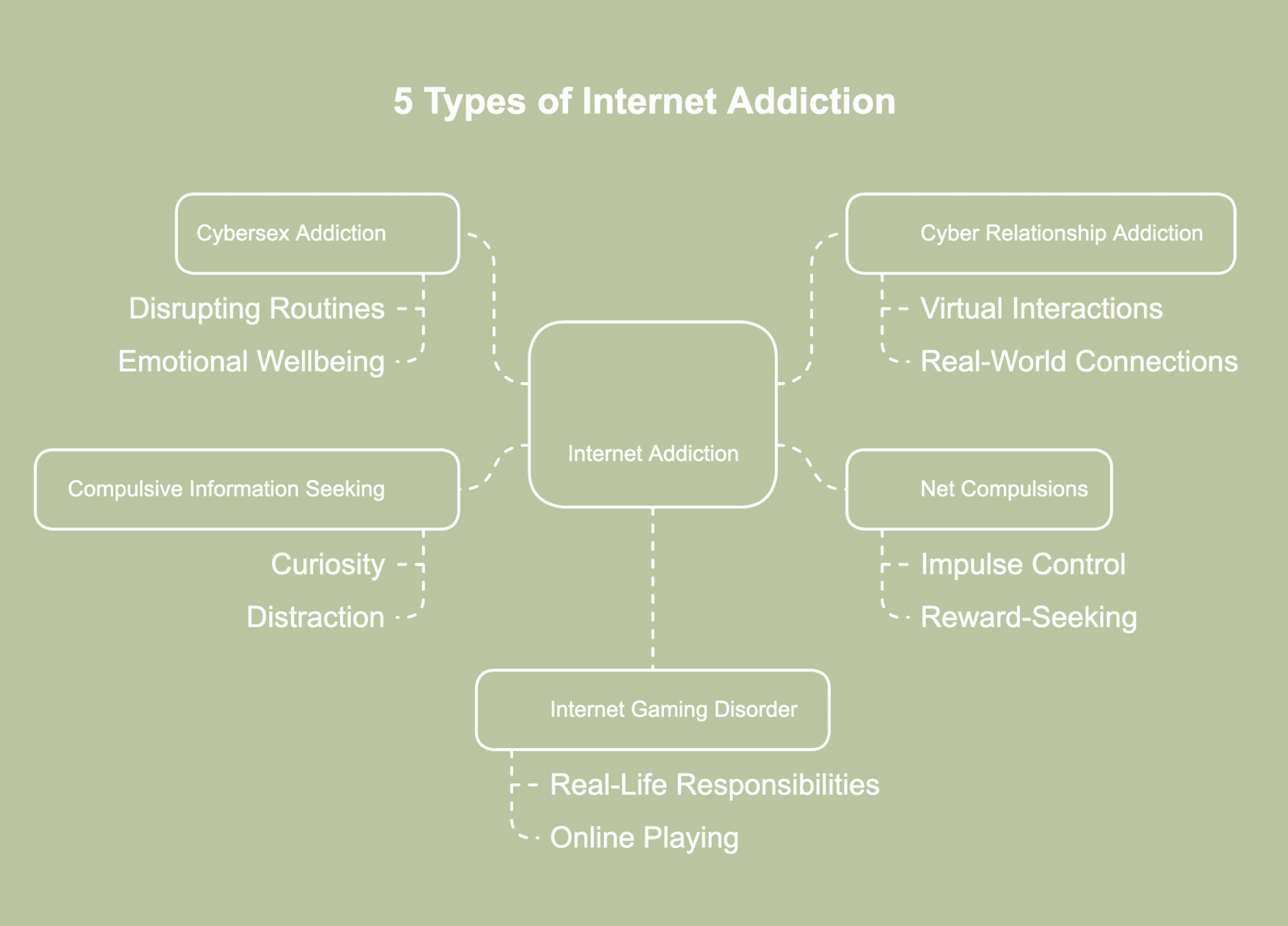
5 types of internet addiction refer to distinct patterns of excessive online behavior interfering with daily life and functioning. The 5 types of internet addiction are listed below.
- Cybersex addiction: Cybersex addiction involves repeated use of online adult content to the point of disrupting normal routines or emotional wellbeing. Affected people struggle to control the urge, even when the secrecy involved leads to conflict in close relationships. Over time, the behavior often replaces healthy intimacy or face-to-face connection. The cycle tends to continue despite feelings of guilt or attempts to stop.
- Cyber (online) relationship addiction: People dealing with an addiction to cyber-relationships often prioritize virtual interactions over real-world connections. Online friendships or romantic exchanges begin to feel more rewarding than in-person bonds, leading to emotional distance from family or partners. As reliance on digital relationships grows, time spent offline becomes less fulfilling.
- Net compulsions: Net compulsions is one of the 5 types of internet addiction, involving behaviors such as excessive online gambling or shopping, where impulse and reward-seeking take control. Individuals often lose track of time or spending while chasing excitement or trying to relieve stress. Even when consequences appear, like debt, strained relationships or work issues, the behavior tends to continue.
- Compulsive information seeking: Certain individuals feel an ongoing need to search for news, trivia or updates, even when the information has no clear use. The habit often starts as curiosity but turns into distraction, reducing attention at work or school. Eventually, the search becomes more about escape than genuine learning.
- Internet gaming disorder (gaming addiction): Gaming or spending long hours on a computer becomes problematic when the activity starts taking priority over real-life responsibilities. Players often stay online to chase progress or protect in-game standing, even when meals, sleep or social connection get ignored. As more time is poured into online playing, daily routines begin to fall apart.
What are the symptoms and signs of internet addiction?
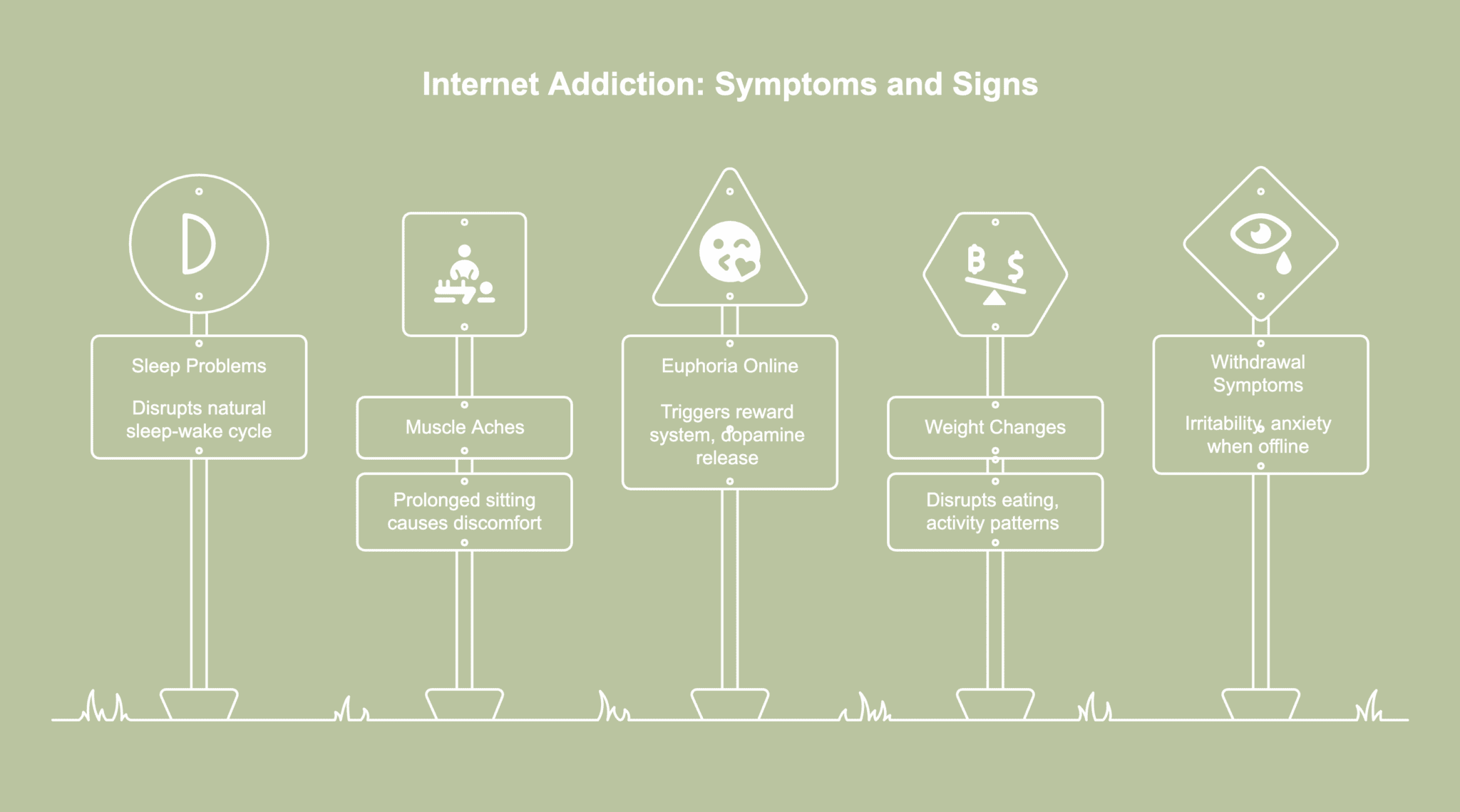
Symptoms and signs of internet addiction describe noticeable behavioral, emotional or physical changes suggesting a person’s online habits have become harmful. The symptoms and signs of internet addiction are listed below.
- Sleep problems: Pathological internet use leads to significant disruptions in sleep patterns, including difficulty falling asleep, staying asleep or maintaining a regular sleep schedule. Blue light from screens disrupts the body’s natural sleep-wake cycle, making restful sleep harder to achieve. The 2022 study “Digital Addiction and Sleep” by Birgitta Dresp-Langley and Axel Hutt examined 2,749 participants, revealing 67.6% scored above 30 on the Internet Addiction Test (IAT), indicating internet addiction. Additionally, 73.5% scored 5 or higher on the Pittsburgh Sleep Quality Index (PSQI), reflecting inadequate sleep quality. Findings identified internet addiction as a significant predictor of poor sleep quality, explaining 13.2% of the variance.
- Muscle aches and pains resulting from inactivity: Prolonged periods of sitting and minimal physical activity while using the internet cause physical discomfort and pain. Common issues include back pain, neck strain and repetitive strain injuries like carpal tunnel syndrome. Lack of movement additionally contributes to poor posture and musculoskeletal problems.
- Euphoria when online: Individuals with internet addiction experience a heightened sense of euphoria or pleasure when online. Similar to addictive substances, engaging in online activities like gambling, interactive gaming, or chatting triggers the reward systems, increasing dopamine release and inducing a euphoric mood in the user, according to a 2015 study by Min Liu and Jianghong Luo, titled “Relationship between peripheral blood dopamine level and internet addiction disorder in adolescents: a pilot study.”
- Unintended weight loss or weight gain: Internet addiction disrupts normal eating patterns and physical activity levels, leading to unintended changes in weight. Affected individuals lose weight due to skipped meals or lack of appetite while online, while others gain weight from snacking or overeating out of boredom or stress.
- Withdrawal symptoms: When internet access becomes unavailable, individuals experience withdrawal symptoms such as irritability or anxiety. Signs of dependence on internet use resemble symptoms seen in other types of addiction. A lack of online activity often leads to a sense of emptiness or loss, resulting in emotional distress.
- Preoccupation with the internet: Constantly thinking about going online or planning the next internet session shows how much control digital use begins to have over the mind. Focus often shifts away from important tasks toward thoughts about games or social media platforms. Online activity becomes the main source of stimulation or escape, crowding out real-life interests in the long run.
- Excessive time online: Internet addicts often devote excessive hours to digital devices, far beyond what is required for work or essential tasks. Constant online engagement continues through meals, social events and late hours. Such habits become evident as disruptions occur in daily routines and responsibilities.
- Problems at work or school: Excessive internet use results in poor performance at work or school, as balancing online activities with responsibilities becomes difficult. Deadlines are often missed, work quality declines, and focus drifts during important tasks. A 2024 research article by Gülçin Güler Öztekin, titled “Associations between internet addiction and school engagement among Turkish college students: mediating role of psychological distress” found a link between higher internet addiction levels and increased stress, anxiety and depression in college students. Adjusting to the school environment and staying engaged becomes more challenging for those experiencing heightened psychological distress.
- Withdrawal from face-to-face social interactions: IA sufferers often reduce in-person interactions, favoring online communication. Social events get skipped, phone calls go unanswered and isolation from friends and family increases. Withdrawal causes relationships to weaken, leading to a noticeable decline in engagement with social activities.
- Lying about internet use: Individuals with internet addiction disorder (IAD) often conceal the true extent of their internet use from family, friends, or colleagues. Many downplay hours spent online or deny engagement when questioned. Dishonesty arises from guilt or a desire to avoid confrontation about excessive screen time. Observers notice inconsistencies in statements or detect secretive behaviors related to online activities.
What are the risk factors for internet addiction disorder (IAD)?
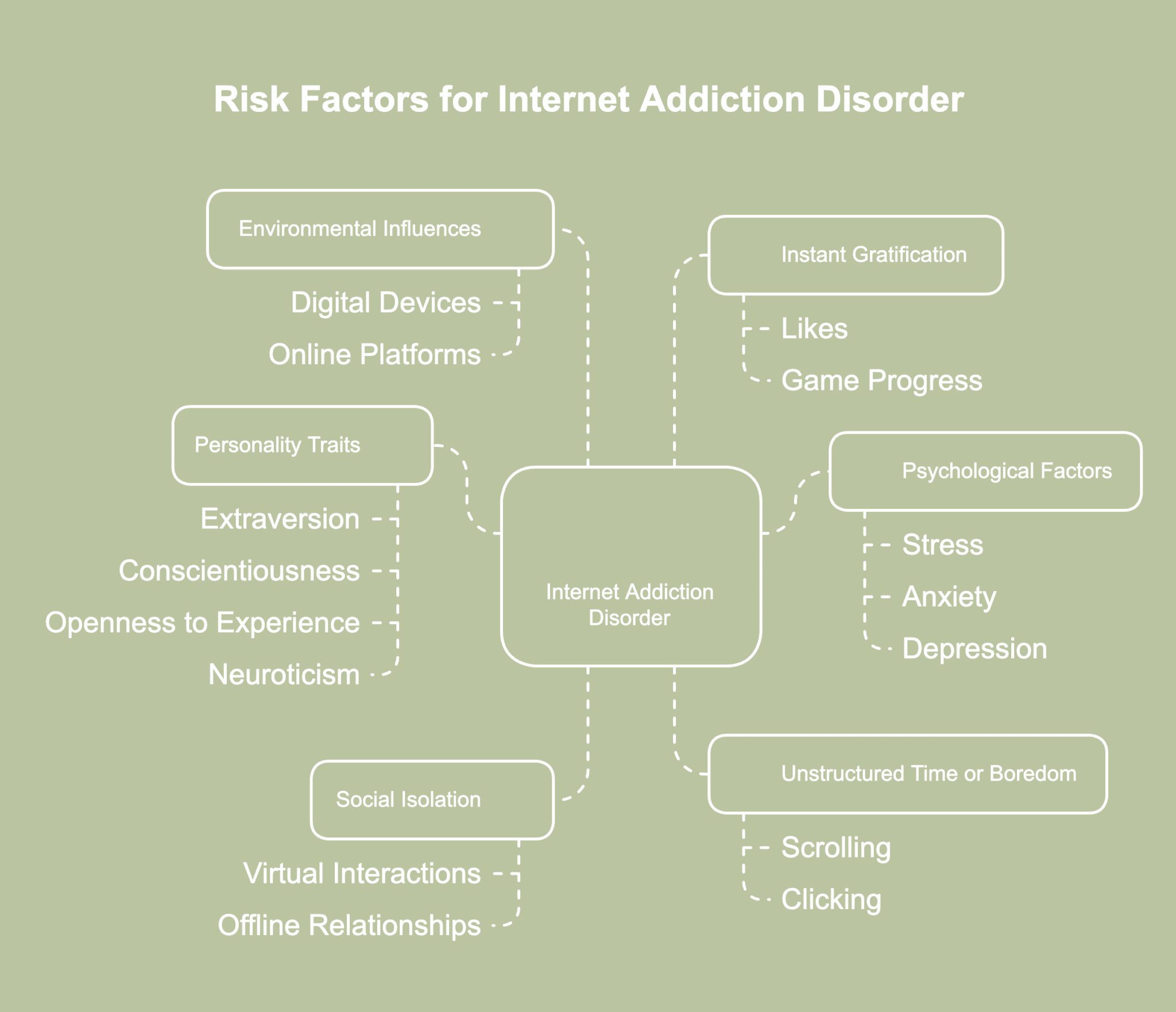
Risk factors for internet addiction disorder (IAD) refer to personal or environmental influences increasing the likelihood of developing unhealthy online habits. The risk factors for internet addiction are listed below.
- Psychological factors: Internet addiction is often traced back to underlying psychological issues such as stress, anxiety, depression or low self-esteem. Individuals use the internet as a means of escape or to find temporary relief from emotional distress. A 2018 study by Manish Kumar and Anwesha Mondal, titled “A study on Internet addiction and its relation to psychopathology and self-esteem among college students” highlighted extensive research on the correlation between psychiatric symptoms and IA in adolescents. Findings revealed a connection between IA and various psychological issues, including reduced self-esteem, anxiety and depression.
- Social isolation: A lack of strong social bonds often pushes individuals toward digital platforms for connection. Virtual interactions provide a quick sense of belonging, even if the connection lacks depth. When offline relationships feel out of reach, online communities begin to fill the gap. As the habit continues, reconnecting with people in real life becomes increasingly difficult.
- Unstructured time or boredom: When daily routines lack purpose or structure, the internet becomes a go-to activity. Many scroll or click through content simply to pass the time, not because of any real interest. Without clear goals or time limits, sessions stretch longer than intended.
- Environmental influences: The pervasive presence of digital devices and easy access to the internet create an environment conducive to developing internet addiction. Since smartphones, tablets and computers are easily within reach, individuals are able to go online almost anytime and anywhere. The design of various online platforms, including social media, gaming and streaming services, is specifically aimed at maximizing user engagement and retention.
- Instant gratification: Various online platforms offer quick rewards, whether through likes or game progress. The fast feedback creates a habit of seeking immediate pleasure rather than working through actual challenges. Waiting or being patient starts to feel uncomfortable. Chasing the quick satisfaction online becomes more appealing than slower, offline rewards.
- Personality traits: Certain traits make individuals more prone to overusing the internet. Personality traits including extraversion, conscientiousness, openness to experience and neuroticism elevate the risk of IA, according to a 2024 study by Ifeoma Juliet Nwufo and Obinna Osita Ike, titled “Personality Traits and Internet Addiction among Adolescent Students: The Moderating Role of Family Functioning.” Strong family support and communication diminish teenagers’ dependency on the Internet, particularly for those with personality features predisposing them to IA.
Who is most vulnerable to internet addiction?
Adolescents and young adults are the most vulnerable to internet addiction. This is mainly due to how deeply technology fits into daily life at such an age. Teenagers often use the internet not just for entertainment but for other purposes like schoolwork, communication and self-expression.
Social media and online playing create a steady stream of distraction, eventually becoming difficult to manage. Emotional ups and downs, combined with the need for social approval, make online spaces feel more comforting than real-life interactions. With brains still developing, younger people struggle more with impulse control and setting boundaries around screen use.
Internet addiction in children has become an increasingly growing concern as well, especially when screen time replaces meaningful family or peer interaction. In numerous cases, children and teens exposed to cyberbullying tend to retreat further into digital spaces, using online activity as a form of escape.
The emotional impact of harmful messages or social rejection online deepen dependence on technology. Without proper support, unhealthy habits around internet use quickly turn into patterns disrupting sleep, school and mental wellbeing.
What are the effects of internet addiction?
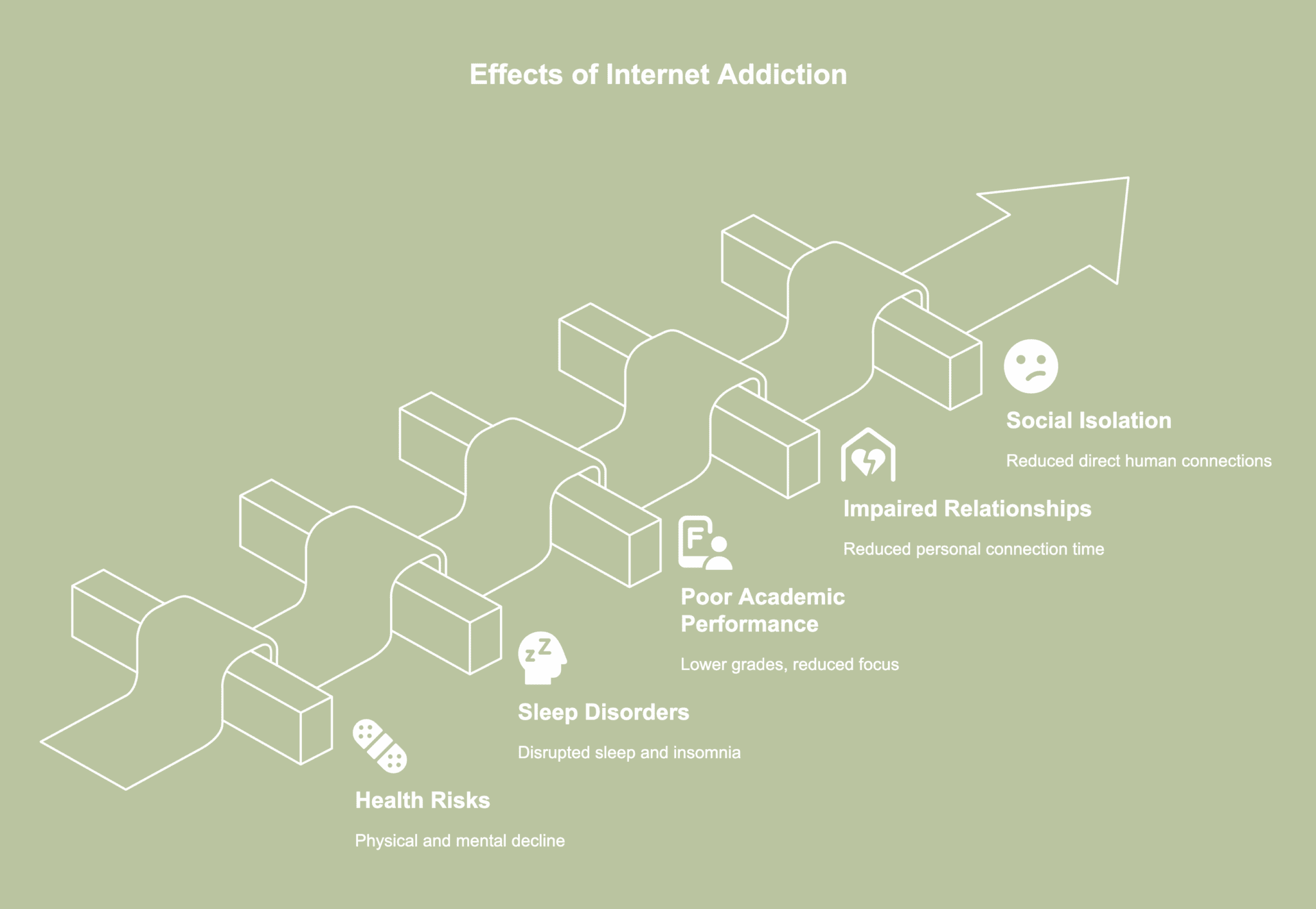
Effects of internet addiction describe the host of unfavorable outcomes stemming from obsessive and excessive internet use. The effects of internet addiction are listed below.
- Health risks: Spending long hours online often leads to health risks such as physical strain, especially in the eyes, back or wrists. Sleep habits usually suffer too, as late-night scrolling or gaming pushes rest aside. Skipping meals or staying sedentary for most of the day weakens the body over time. Without balance, daily health slowly declines while screen time takes center stage.
- Sleep disorders: Prolonged and frequent internet usage, particularly during late hours, disturbs one’s regular sleep cycle and contributes to the development of sleep disorders. The blue light projected from screens disrupts the body’s innate circadian rhythms, resulting in increased difficulty in both falling asleep and maintaining sleep. Individuals additionally suffer from insomnia or disrupted sleep patterns as a result of spending excessive amounts of time online.
- Poor academic performance: Students struggling with internet addiction disorder often face difficulties focusing on studies and completing assignments punctually. Distractions from online activities lead to procrastination and reduced study time, causing lower grades and overall poor academic performance. A survey conducted by Javaeed et al., in a 2020 study titled “Relationship Between Internet Addiction and Academic Performance of Undergraduate Medical Students of Azad Kashmir” found just 3 (0.9%) out of 316 medical students reported no signs of addiction, while 89 (28.2%) displayed extreme dependency. Compared to peers with healthier internet habits, those heavily reliant on digital engagement performed noticeably worse on tests.
- Impaired relationships: IA strains relationships with family, friends and romantic partners due to reduced time and attention devoted to personal connections. Misunderstandings, conflicts, impaired relationships, and sentiments of disregard from loved ones are the consequences of such neglect. The lack of consistent, high-quality interaction wears down relationships over time, chipping away at trust and intimacy.
- Social isolation: While the internet offers opportunities for virtual interactions, online engagement often leads to social isolation. Individuals addicted to the internet often withdraw from in-person social activities, choosing to engage with online communities instead. A 2023 article titled “The Internet and Loneliness” by Andrew P. Smith and Hasah Alheneidi explained the displacement hypothesis, which suggests that relying on digital interactions to avoid social engagement increases loneliness by reducing direct human connections.
- Mental health struggles: Heavy internet use often worsens feelings of anxiety or low mood, especially when online spaces become a main source of comfort. Affected people begin to feel overwhelmed, disconnected or emotionally drained after spending too much time doom scrolling or gaming. Social comparison and negative interactions online create pressure many find difficult to escape. As real-life relationships fade into the background, one’s mental health tends to suffer.
What are the treatment options for internet addiction?
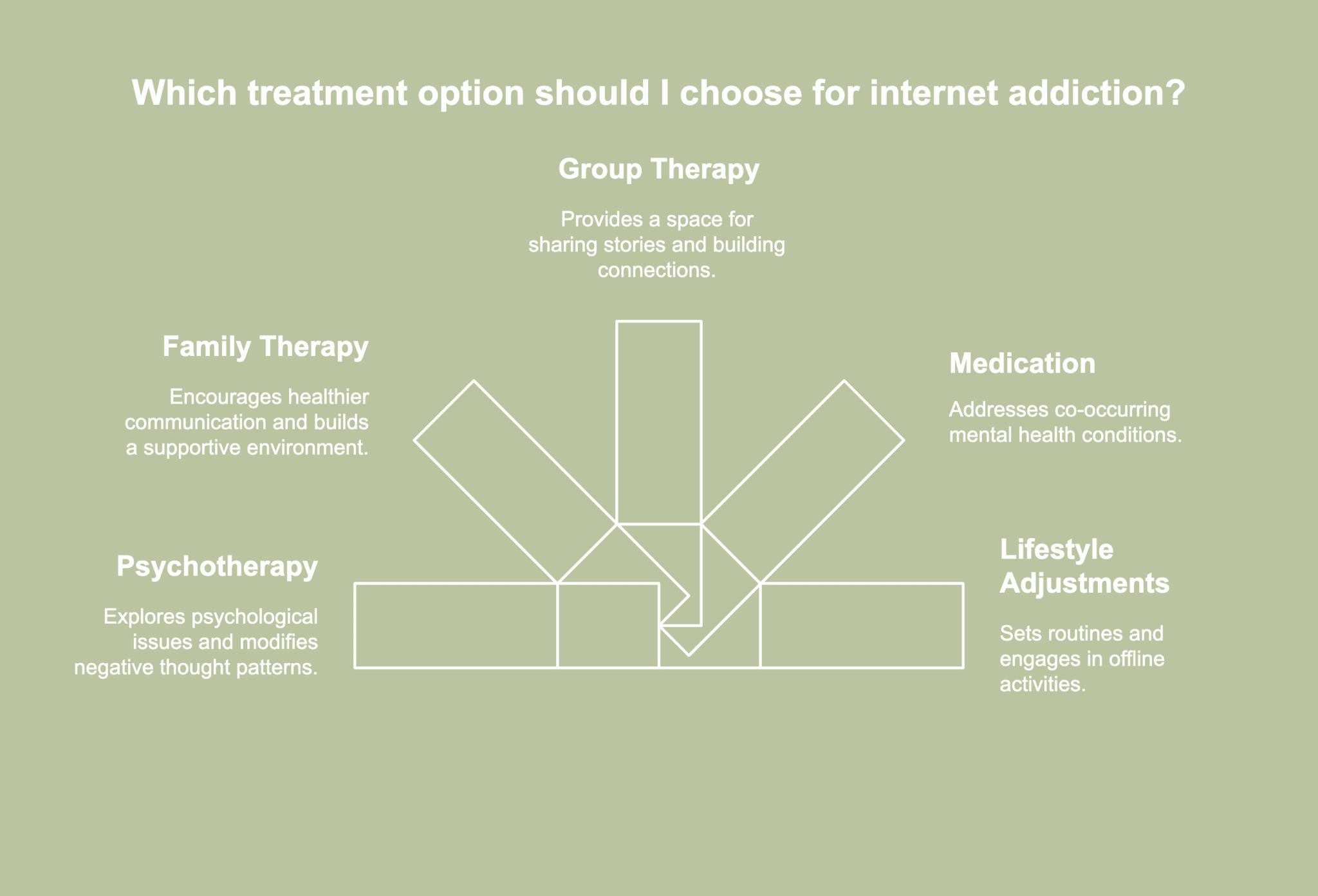
Treatment options for internet addiction refer to different therapeutic interventions employed to help individuals regain control over unhealthy online habits and rebuild balance in daily life. The treatment options for internet addiction are listed below.
- Psychotherapy: Psychotherapy or talk therapy uses different strategies to explore the psychological issues contributing to internet addiction. A 2018 study by Manoj Kumar Sharma and Thamil Selvan Palanichamy, titled “Psychosocial interventions for technological addictions,” pointed to motivational enhancement therapy and cognitive behavioural therapy (CBT) as the most thoroughly explored treatments for technology-related addictions, including internet addiction. The research further explained how motivational interviewing helps individuals recognize emotions experienced just before engaging in online activities and identify the feelings being managed through such behavior. In contrast, CBT remains a widely used therapeutic approach assisting individuals in identifying and modifying negative thought patterns and behaviors linked to internet addiction.
- Family therapy: Family therapy brings loved ones into the recovery journey to help uncover how relationship dynamics are likely to fuel internet addiction. The process encourages healthier communication and builds a more supportive environment. Family members additionally gain a clearer understanding of what internet addiction looks like and how the condition affects behavior, often resulting in greater empathy. When support at home grows stronger, individuals tend to recover with more confidence and stability.
- Group therapy: Group therapy creates a space where individuals facing similar struggles share stories without fear of judgment. Hearing others speak openly helps reduce shame and builds a sense of connection internet addicts often lack. Members support one another through honest conversations and accountability.
- Medication: When internet addiction occurs alongside other mental health conditions, specific medications become part of the treatment approach. A 2024 review titled “Internet Addiction Management: A Comprehensive Review of Clinical Interventions and Modalities” by Chadha et al., explained how antidepressants and anxiolytics, commonly used for co-occurring disorders, help address internet addiction. Ongoing research explores medications such as naltrexone, designed to target compulsive online behaviors directly.
- Lifestyle adjustments: Adjusting daily habits plays a big role in overcoming internet addiction and feeling better overall. Setting a clear routine with specific windows for screen time helps keep usage under control. Filling the day with offline activities like hobbies or exercise brings enjoyment from other sources and helps restore balance.
What are the symptoms of internet addiction withdrawal?
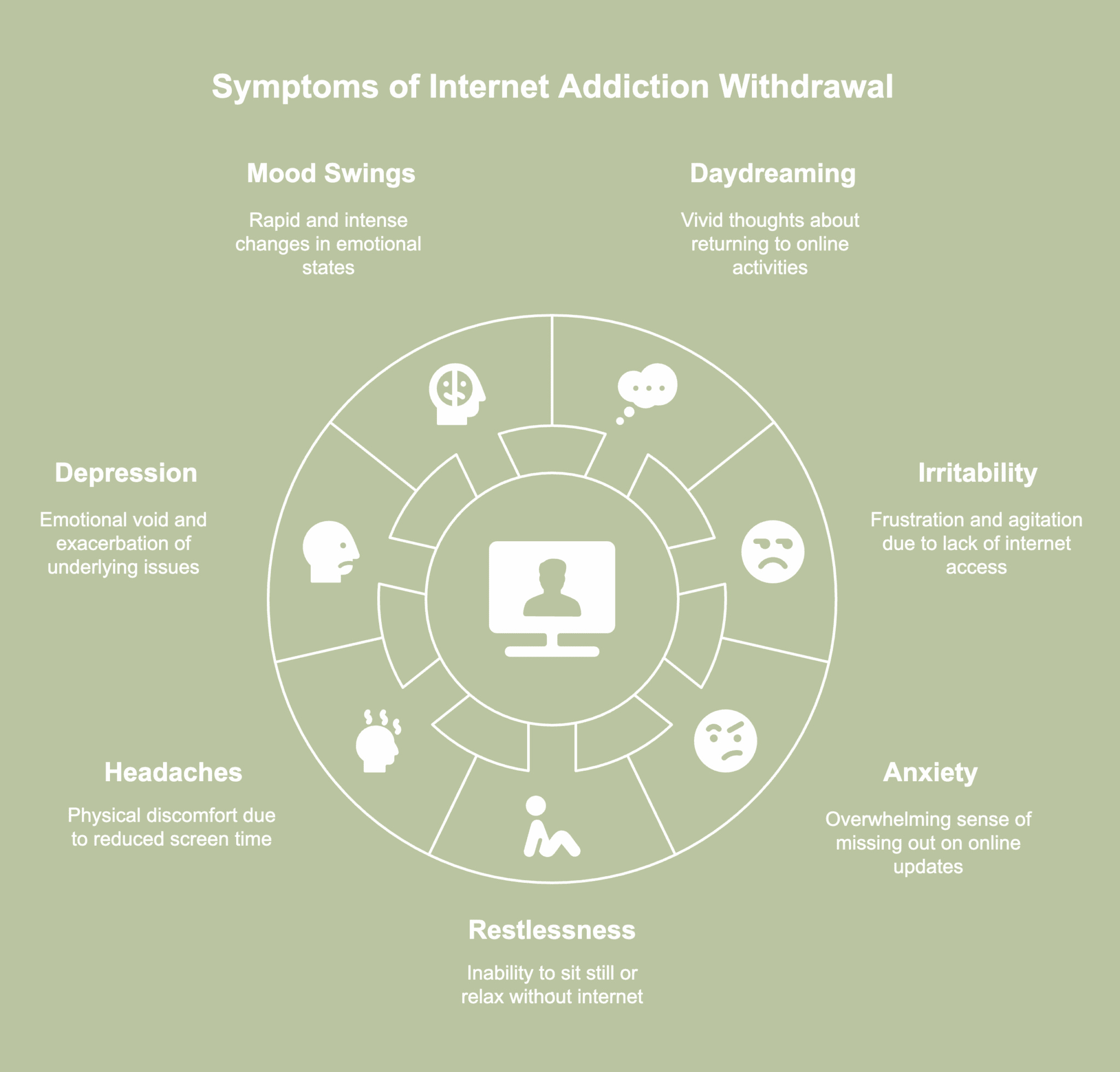
Symptoms of internet addiction withdrawal refer to the reactions emerging when an individual significantly reduces or cuts back on excessive internet use. The symptoms of internet addiction withdrawal are listed below.
- Daydreaming about going back online: Limited access to the internet often triggers vivid thoughts about returning to favorite platforms or online activities. Thoughts often feel intrusive, pulling attention away from daily tasks or conversations. The craving for digital activity grows so intense, real life begins to feel dull in comparison. Such a mental fixation signals the brain’s struggle to adjust without constant stimulation from online spaces.
- Irritability: Irritability often appears as a symptom of internet addiction withdrawal, marked by frustration and agitation when internet access is unavailable. Heightened annoyance or anger surfaces in response to minor inconveniences. The absence of online engagement disrupts usual coping mechanisms, making a person more reactive to stress.
- Anxiety: Being offline often triggers an overwhelming sense of missing out on important updates or interactions. Anxiety disrupts daily activities, making focus and relaxation more challenging. A 2019 study by Saikia et al., titled “Internet Addiction and its Relationships with Depression, Anxiety, and Stress in Urban Adolescents of Kamrup District, Assam” comprised a sample of 440 students from higher secondary schools and colleges. 80.7% of the subjects exhibited internet addiction. A total of 83.3% of the participants with internet addiction reported experiencing anxiety.
- Restlessness: Restlessness is marked by an inability to sit still or relax, often with a constant urge to check the internet. The symptom results from the sudden lack of constant stimulation provided by online activities. The affected individual paces, fidgets or struggles to focus on tasks without the distraction of the internet.
- Headaches: Headaches occur as a physical symptom of internet addiction withdrawal, possibly due to changes in screen time and altered routines. The sudden reduction in screen exposure leads to tension headaches as the body adjusts. Dehydration, poor posture, and eye strain from previous excessive use are potential contributors as well.
- Depression: The reduction in internet use leaves a void, exacerbating underlying emotional issues. A 2023 article by Zhao et al., titled “Network analysis of internet addiction and depression among Chinese college students during the COVID-19 pandemic: A longitudinal study” revealed a substantial comorbidity between depression and IA in college students. The symptoms “guilty” (a depression symptom) and “escape” (an IA symptom) were central, functioning as bridge symptoms in the network, suggesting an essential role in the connection between IA and depression.
- Mood swings: Mood swings are characterized by rapid and intense changes in emotional states. Individuals experience sudden shifts from happiness to irritability or sadness without clear triggers. Mood swings are challenging to manage and often affect relationships and daily functioning.
How do I overcome internet addiction?
To overcome internet addiction, you must have a structured plan incorporating self-awareness, behavioral changes and reliable support systems, best organized into 12 practical steps.
The 12 steps to overcome internet addiction include strategies such as acknowledging the problem, setting specific goals and limits for internet use, creating a balanced daily routine with offline activities, identifying triggers, using productivity tools, seeking professional help, building a support network, creating technology-free zones, practicing mindfulness and setting device-free times.
The 12 steps listed above play a vital role in maintaining recovery because each one offers a detailed strategy for dealing with different facets of addiction. Following a clear plan enables people to successfully combat internet addiction, recover control over digital use and develop a more grounded lifestyle.
What is a digital detox?
A digital detox refers to intentionally stepping away from screens and reducing technology use for a set period of time. The goal is to create space for rest and reconnection with the physical world without constant interruptions from devices.
People on digital detox choose to unplug during weekends, holidays or stressful moments to break the cycle of endless scrolling or checking notifications. Taking regular breaks from digital input helps improve focus, sleep and emotional wellbeing while encouraging more mindful use of technology moving forward.
Along with self-control smartphone applications and internet blocking and filtering software, digital detox programs are practical tools for managing internet use, as noted in a 2024 paper titled “Internet Addiction Management: A Comprehensive Review of Clinical Interventions and Modalities” by Chadha et al.
How do you help someone with problematic internet use?
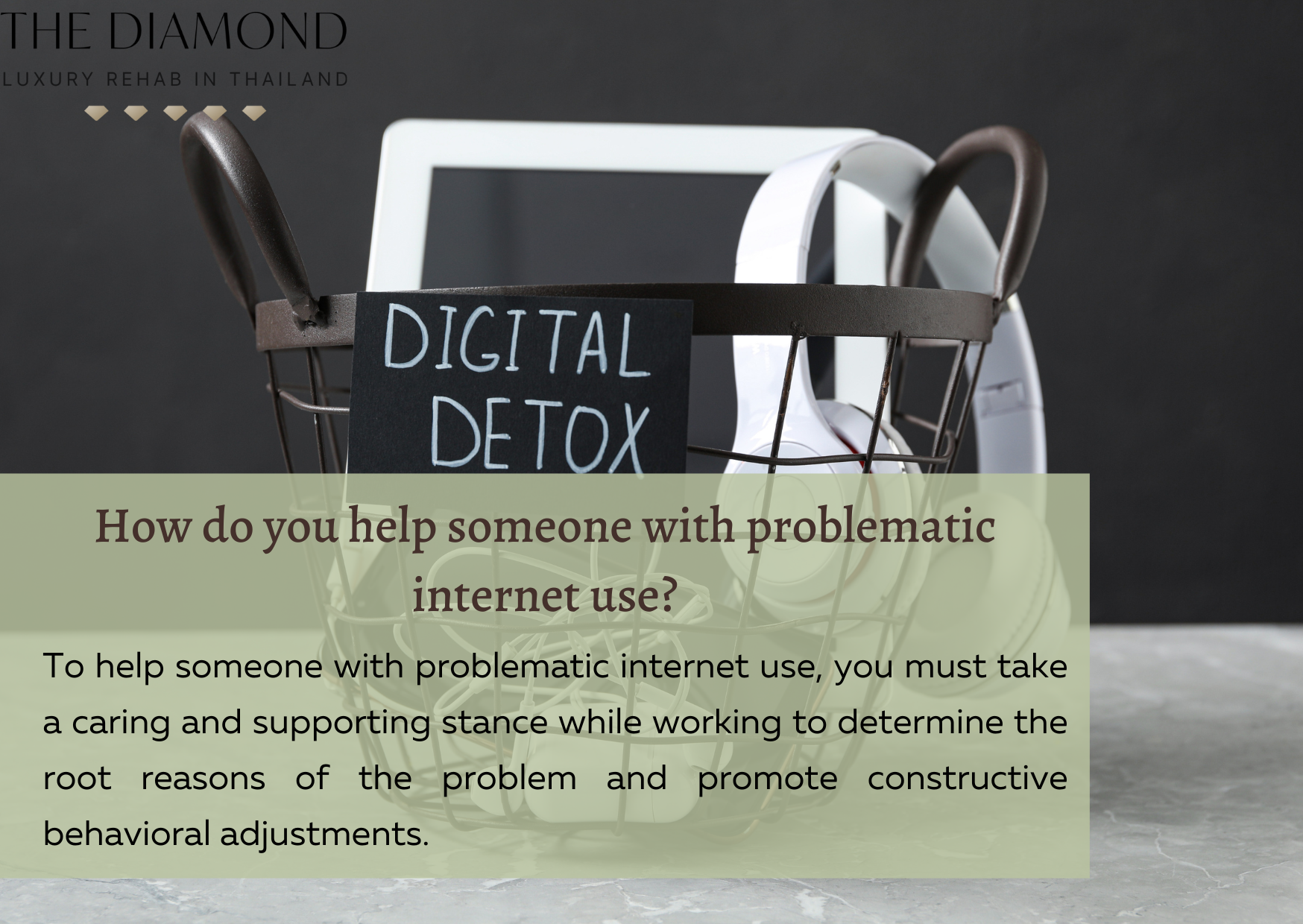
To help someone with problematic internet use, you must take a caring and supporting stance while working to determine the root reasons of the problem and promote constructive behavioral adjustments. Encouraging open, accepting conversations about challenges creates a safe space for expression.
Particularly when attempting to manage teen internet addiction, setting clear, consistent limits on internet use fosters healthier habits. Encouraging involvement in offline activities, such as hobbies or sports, offers fulfilling alternatives.
Professional assistance, like therapy or counseling, deals with underlying mental health problems and gives the person coping mechanisms. Involving friends and family in the healing process additionally builds a strong support system, providing accountability and encouragement.

